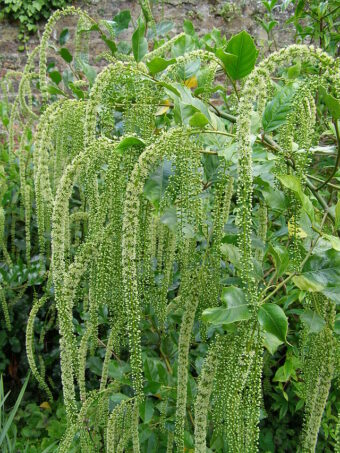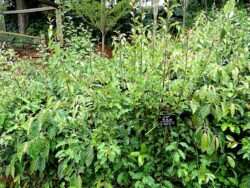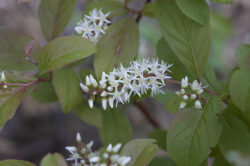In this article, we will be discovering how to grow the long spiked flowering shrub of Itea in containers. Itea is a small genus of 10 species of shrub and small trees. The flowers that are produced are normally scented and hence why it has the common name of sweet spire.

The flowers are either borne in racemes as found in Itea ilicifolia or like spikes as in Itea virginica. The plant is natively found in Eastern Asia and one deciduous species comes from North America. They tend to be grown for the long raceme flower but the leaves can be attractive as well. The shrub can either have evergreen leaves or deciduous as found in the species that are often grown in the UK.
Find out how to grow the beautiful flowering shrub of Itea in containers
GROWING ITEA IN CONTAINERS
They will grow well in containers if you provide a well-drained but relatively fertile compost. First, choose a large container such as a half-barrel and make sure it has plenty of drainage holes at the bottom. To this container, add a 2cm layer of gravel to create a route where excess water can drain away. On top of this add multipurpose compost to which a handful of manure has been added. Fill the container to 5cm below the rim
Dig a hole in the centre of the container in the compost slightly bigger than the root ball it came in the original container that you purchased. Drop the plant in so that the top of the root ball is at the same level as the top surface of the compost in the container. Backfill with the growing media so that no vacant areas remain, using more compost if you find it necessary. Firm the plant in and water around the roots. The good news is that the plant is slow growing.
THE BEST GROWING CONDITIONS

It is best to grow Itea near a wall where the growth can be supported. Some species prefer to be grown in full sun (such as Itea ilicifolia and Itea yunnanensis) whilst Itea viriginica prefers to be grown in partial shade.
They will need to be kept moist at all times, especially Itea virginica, whilst the others can take some drought. It is best to water every time it feels dry at a depth of 5cm below the surface of the compost. Water until it emerges from the drainage holes.
They are slightly demanding in terms of how much fertilizer it needs, I feel that an annual dressing of slow-release fertilizer applied in early spring will be enough to get it through the growing season.
Pruning is not necessary at all but you can cut back dead branches or any unwanted branches in winter. This can keep it compact as well.
Propagation is relatively simple as all you need to do is take semi-ripe cuttings in summer to grow in a cold frame for planting the following year.
PESTS AND DISEASES
The good news is that the plant does not suffer from any pests or diseases but they can suffer from chlorosis in alkaline growing conditions, If you use multipurpose compost you should be fine, but if experienced you will need to feed with phosphate of Iron and it will recover.
it tends to form suckering stems and new shoots will grow at the base of the plant. You can use these suckers to propagate the plant or if you do not want them, you can cut the old shoots and discard them.
VARIETIES TO GROW

3 species can be grown in the UK; 2 more common and one is less likely to be found.
The most common one which needs a very large container is Itea ilicifolia (Holly-leaf Sweetspire) which can grow up to 3m tall. It has holly-like leaves that are dark green above and silver below. In late summer and early autumn, 15 to 30cm long catkin-like racemes appear that will make the plant look stunning.
Another similar plant that is slightly shorter and produces longer racemes is Itea yunnanensis. It grows up to 2.5m high and produces 35cm long flowers on younger plants (not much so as the plant ages). The leaves are also holly-like and the flowers appear from August onwards.
A more compact species is Itea virginica which is completely different to the other two. The leaves are oval and not oval-like and the flowers are smaller and white. They are borne in upright cylindrical flower heads and appear a bit earlier in July. The leaves turn red in autumn before falling from the shrub. Two noted varieties are ‘Little Henry’ and ‘Love Child’.
CONCLUSIONS
In this article we have discussed how to grow the beautiful long flowering shrub of Itea. The flowers are long, the leaves are interesting and it is easy to grow and care for. They are limited varieties but what varieties you can find are all beautiful. I recommend that you grow one today.
If you have any questions or comments that you wish to make about growing Itea in containers, please do so in the comment box below.
Happy Itea growing.
